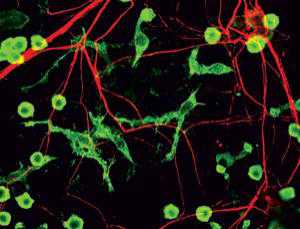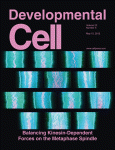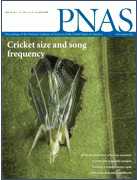Neuron:小神经胶质细胞可保护机体免于退行性脑病
2012-06-17 T.Shen 生物谷
绿色代表突触 (Image: Gerry Shaw/Wikimedia) 一些免疫细胞可以破坏大脑中闲置的神经回路以及神经细胞之间的联系,甚至在健康的个体中也是如此,理解这种过程可以帮助我们避免退行性脑病的发病。 时至今日,小神经胶质细胞被认为是普通的免疫细胞,可以保护大脑免于损伤以及免于大脑疾病再生。 来自波士顿儿童医院的研究者Beth Stevens表示,小神经胶质细胞可以清理大脑中的残

绿色代表突触 (Image: Gerry Shaw/Wikimedia)
一些免疫细胞可以破坏大脑中闲置的神经回路以及神经细胞之间的联系,甚至在健康的个体中也是如此,理解这种过程可以帮助我们避免退行性脑病的发病。
时至今日,小神经胶质细胞被认为是普通的免疫细胞,可以保护大脑免于损伤以及免于大脑疾病再生。
来自波士顿儿童医院的研究者Beth Stevens表示,小神经胶质细胞可以清理大脑中的残骸碎片,这种理念已经在大脑疾病的研究中建立起来了。但是如今,除了对大脑损伤产生反应以外,我们也发现了小神经胶质细胞可以对突出功能的细微改变也可以做出反应。相关研究成果刊登在了近日的国际杂志Neuron上。
Stevens和同事们对小鼠进行操作,使小鼠一只眼睛比另一只更有活性,这就产生了两个眼睛-大脑不一致活性的神经回路。
研究者用染色的方法来区分从左眼到右眼的信号,随后研究者解剖了小鼠尸体,发现小神经胶质细胞可以在优先修复活性不足眼睛的神经回路的连接或者突触的接触。神经突触是用一种免疫化学物C3标记的,用来指示神经回路的破坏。研究为什么这些神经突触被标记以指示器消除的速度,将有助于我们预防退行性脑病。
早期的突触缺失是许多退行性神经疾病的一个特点,因此研究是什么触发导致突触的缺失对于预防脑病的发生至关重要。小神经胶质细胞被认为只是垃圾收集器,然而其给研究者带来了更为深入和有趣的研究,在我们了解其在脑病中扮演的角色之前,我们需要了解这些小神经胶质细胞到底有什么样的功能。(生物谷:T.Shen编译)
编译自:http://www.newscientist.com/article/mg21428675.500-immune-cells-gobble-up-healthy-but-idle-brain-cells.html

doi:10.1016/j.neuron.2012.03.026
PMC:
PMID:
Microglia Sculpt Postnatal Neural Circuits in an Activity and Complement-Dependent Manner
Dorothy P. Schafer, Emily K. Lehrman, Amanda G. Kautzman, Ryuta Koyama, Alan R. Mardinly, Ryo Yamasaki, Richard M. Ransohoff, Michael E. Greenberg, Ben A. Barres, Beth Stevens
Microglia are the resident CNS immune cells and active surveyors of the extracellular environment. While past work has focused on the role of these cells during disease, recent imaging studies reveal dynamic interactions between microglia and synaptic elements in the healthy brain. Despite these intriguing observations, the precise function of microglia at remodeling synapses and the mechanisms that underlie microglia-synapse interactions remain elusive. In the current study, we demonstrate a role for microglia in activity-dependent synaptic pruning in the postnatal retinogeniculate system. We show that microglia engulf presynaptic inputs during peak retinogeniculate pruning and that engulfment is dependent upon neural activity and the microglia-specific phagocytic signaling pathway, complement receptor 3(CR3)/C3. Furthermore, disrupting microglia-specific CR3/C3 signaling resulted in sustained deficits in synaptic connectivity. These results define a role for microglia during postnatal development and identify underlying mechanisms by which microglia engulf and remodel developing synapses.
本网站所有内容来源注明为“梅斯医学”或“MedSci原创”的文字、图片和音视频资料,版权均属于梅斯医学所有。非经授权,任何媒体、网站或个人不得转载,授权转载时须注明来源为“梅斯医学”。其它来源的文章系转载文章,或“梅斯号”自媒体发布的文章,仅系出于传递更多信息之目的,本站仅负责审核内容合规,其内容不代表本站立场,本站不负责内容的准确性和版权。如果存在侵权、或不希望被转载的媒体或个人可与我们联系,我们将立即进行删除处理。
在此留言














#脑病#
72
#神经胶质细胞#
79
#Neuron#
70
#胶质细胞#
50